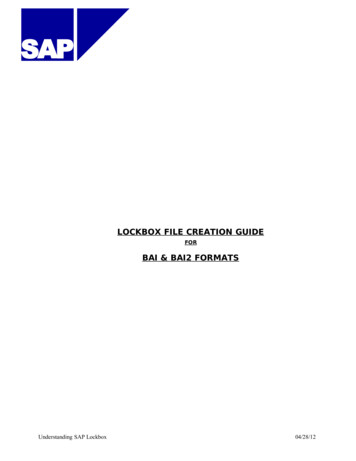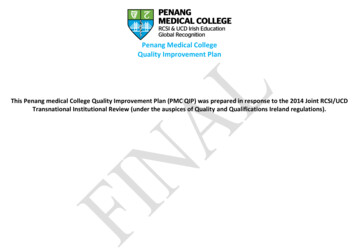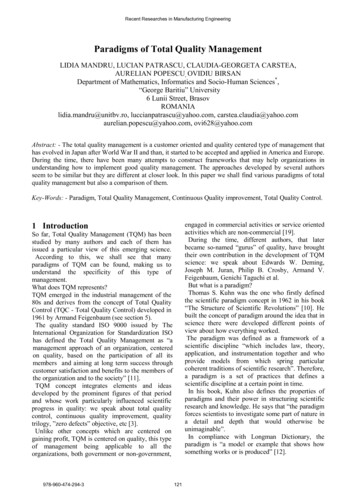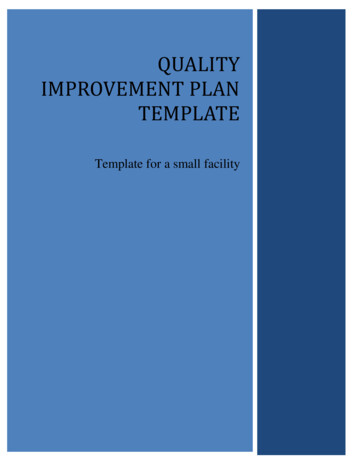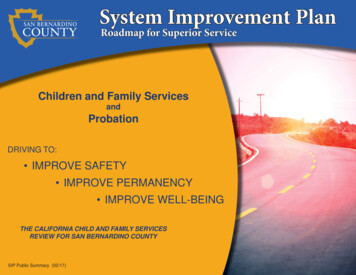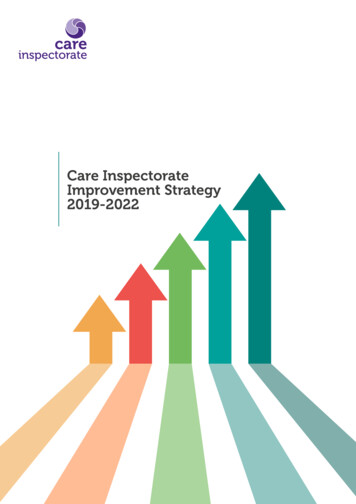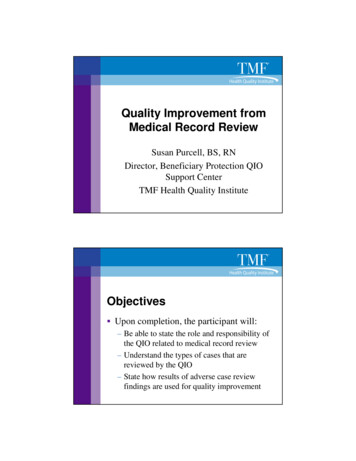
Transcription
Quality Improvement fromMedical Record ReviewSusan Purcell, BS, RNDirector, Beneficiary Protection QIOSupport CenterTMF Health Quality InstituteObjectives Upon completion, the participant will:– Be able to state the role and responsibility ofthe QIO related to medical record review– Understand the types of cases that arereviewed by the QIO– State how results of adverse case reviewfindings are used for quality improvement
QIOs: Who Are They,What Do They Do? Work under contract with the Centers for Medicare &Medicaid Services (CMS) One for each state/U.S. territory Ensure care delivered to Medicare beneficiaries is:– Medically necessary/reasonable– Provided in most appropriate setting– Of a quality that meets professionally recognized standards ofhealth careQIO Contract Objectives –9th Scope of Work National Theme Responsibilities– Beneficiary Protection Case Review Quality Improvement Activities Quality Data Reporting – Annual payment update– Patient Safety Hospitals & Nursing Homes––––Improve surgical care and heart failure core measuresReduce pressure ulcers in both settingsNew focus for hospitals – MRSAReduction of the use of restraints in nursing homes
QIO Contract Objectives –9th Scope of Work National Theme Responsibilities (continued)– Prevention Screening tasks– Mammography– Colorectal cancer screening Immunization tasks– Influenza– PnuemococcalQIO Contract Objectives –9th Scope of Work Sub-national Theme Responsibilities– Prevention: Disparities– Prevention: Chronic Kidney Disease– Care Transitions
Medicare Case Review Types of Medicare case review the QIO willreview:– Regulatory Examples : review of hospital-submitted, higher-weighteddiagnosis-related groups (DRGs), referrals from otheragencies, such as OIG or FI, EMTALA– Beneficiary-initiated Example: beneficiary complaint regarding the quality ofcare received; beneficiary-initiated discharge appealMedicare Case Review Types of case review that are performed:– DRG validation– Utilization– Appeals of discharge from services– Quality
Quality Improvement fromMedical Record Review What types of quality improvementactivities can occur as the result of casereview findings?
Quality Improvement fromMedical Record Review Sanction activity– Social Security Act– Code of Federal Regulations Required by law and regulation in egregious cases Occurs very infrequently May result in a corrective action plan thatresults in improvement in quality of careQuality Improvement fromMedical Record Review Most quality of care issues are not egregious Frequently the quality issues are the result ofpoor processes Can be human factor errors– Execution– Planning– Violation
Quality Improvement fromMedical Record Review Types of quality improvement activities thatmay result from case review:– Physician education CME Focused re-education in a specific or broad area– Development of a quality improvement plan When systems or processes of care delivery can beimprovedQuality Improvement fromMedical Record Review Types of quality improvement activities thatmay result from case review (continued):– Physician review may recommend: Consideration of an alternative approach to future care– When a different method of care delivered could be expectedto improve the care Offer advice to the provider/practitioner– When a more current method of care could have beenconsidered although the quality of the care was adequate
Quality Improvement fromMedical Record Review Less frequent types of qualityimprovement activities– Meeting with the physician/provider todiscuss the care that was provided– Discussion with provider regarding theiroversight of care, performance improvementprocesses, internal QIQuality Improvement fromMedical Record Review How is it determined that the qualityimprovement efforts were successful?– Additional record review– Self-monitoring reports fromphysician/provider– Analysis of claims data
New Requirements from CMS:9th Scope of Work “Perform quality improvement activities that focus onsystem wide change.”– System-wide change is defined as: A change which normally has an impact beyond an individualbeneficiary or provider; Results in a tangible improvement to a system or process; and Improves the quality of health care for Medicare beneficiaries. “Demonstrate that improvements linked to the system-wide change are realized over a 12 month period.”– e.g., attribution that the change resulted in improvement .
Example QIA:A Near Miss in the ER Problem: Incorrect medication order Intervention: QIA to include root cause analysis with actionplan focused on medication management system, currentperformance level and measurement of performance afterchanges Outcome: Decreased errors in medication orders Level of Impact: Starting point: 10% error rate; Afterintervention: 2% error rate by month one, 0% errors within 6months and sustained improvement over the next 12 monthsExample QIA:Wandering Patient Problem: Safety process breakdown Intervention: QIA to include root cause analysis with actionplan focused on patient safety, current performance level andmeasurement of performance after changes Outcome: Risk assessments conducted on all admissions Level of Impact: Starting point: 85% After intervention: 100% compliance within 6 months andsustained improvement over the next 12 months
Example QIA:Repeated Falls Problem: Lack of Fall Prevention Plan Intervention: QIA to include root cause analysis with actionplan focused on fall prevention, current performance leveland measurement of performance after changes Outcome: Fall risk assessments conducted on all admissions: Level of Impact: Starting point: 80% compliance After intervention: 90% by month 4, 100% by month 6 withsustained improvement over the past 12 monthsExample QIA:IV Process Problem: Staff failed to obtain daily weights Intervention: QIA to include root cause analysis with actionplan focused on parental nutrition, current performance leveland measurement of performance after changes Outcome: All patients receiving parenteral nutrition areweighed daily Level of Impact: Starting point: 80% After intervention: 90% by month 4, 100% by month 6 withsustained improvement over the past 18 months
Quality Improvement fromCase Review Concluding thoughts Questions?Quality Improvement fromCase ReviewContact information:Susan Purcell, BS, RNspurcell@txqio.sdps.org512-334-1702This material was prepared by TMF Health Quality Institute, the Quality Improvement Organization SupportCenter for the Beneficiary Protection Program, under contract with the Centers for Medicare & Medicaid Services(CMS), an agency of the U.S. Department of Health and Human Services. 8SOW-TX-BPPQ-08-55
Medical Record Review Types of quality improvement activities that may result from case review: - Physician education CME Focused re-education in a specific or broad area - Development of a quality improvement plan When systems or processes of care delivery can be improved Quality Improvement from Medical Record Review


